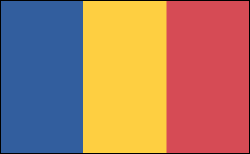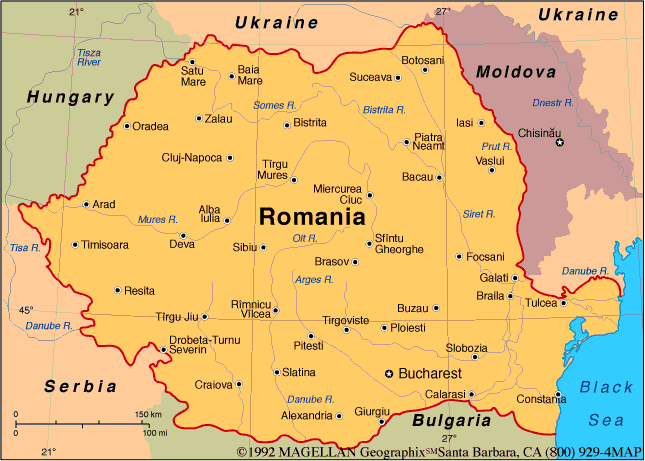ROMANIA

Geography: Romania is in southeast Europe and is slightly smaller than Oregon. The Carpathian Mountains divide Romania's upper half from north to south and connect near the center of the country with the Transylvanian Alps, running east and west. North and west of these ranges lies the Transylvanian plateau, and to the south and east are the plains of Moldavia and Walachia. In its last 190 mi (306 km), the Danube River flows through Romania only. It enters the Black Sea in northern Dobruja, just south of the border with Ukraine.
Government: Republic.
History: Most of Romania was the Roman province of Dacia from about A.D. 100 to 271. From the 3rd to the 12th century, wave after wave of barbarian conquerors overran the native Daco-Roman population. Subjection to the first Bulgarian Empire (8th–10th century) brought Eastern Orthodox Christianity to the Romanians. In the 11th century, Transylvania was absorbed into the Hungarian empire. By the 16th century, the main Romanian principalities of Moldavia and Walachia had become satellites within the Ottoman Empire, although they retained much independence. After the Russo-Turkish War of 1828–1829, they became Russian protectorates. The nation became a kingdom in 1881 after the Congress of Berlin.
At the start of World War I, Romania proclaimed its neutrality, but it later joined the Allied side and in 1916 declared war on the Central Powers. The armistice of Nov. 11, 1918, gave Romania vast territories from Russia and the Austro-Hungarian Empire, doubling its size. The areas acquired included Bessarabia, Transylvania, and Bukovina. The Banat, a Hungarian area, was divided with Yugoslavia. King Carol II was crowned in 1930 and transformed the throne into a royal dictatorship. In 1938, he abolished the democratic constitution of 1923. In 1940, the country was reorganized along Fascist lines, and the Fascist Iron Guard became the nucleus of the new totalitarian party. On June 27, the Soviet Union occupied Bessarabia and northern Bukovina. King Carol II dissolved parliament, granted the new prime minister, Ion Antonescu, full power, abdicated his throne, and went into exile.
Romania subsequently signed the Axis Pact on Nov. 23, 1940, and the following June joined in Germany's attack on the Soviet Union, reoccupying Bessarabia. About 270,000 Jews were massacred in Fascist Romania. Following the invasion of Romania by the Red Army in Aug. 1944, King Michael led a coup that ousted the Antonescu government. An armistice with the Soviet Union was signed in Moscow on Sept. 12, 1944. A Communist-dominated government bloc won elections in 1946, Michael abdicated on Dec. 30, 1947, and in 1955 Romania joined the Warsaw Treaty Organization and the United Nations.
Running a neo-Stalinist police state from 1967–1989, Nicolae Ceausescu wound the iron curtain tightly around Romania, turning a moderately prosperous country into one at the brink of starvation. To repay his $10 billion foreign debt in 1982, he ransacked the Romanian economy of everything that could be exported, leaving the country with desperate shortages of food, fuel, and other essentials. An army-assisted rebellion in Dec. 1989 led to Ceausescu's overthrow, trial, and execution.
Government: Republic.
History: Most of Romania was the Roman province of Dacia from about A.D. 100 to 271. From the 3rd to the 12th century, wave after wave of barbarian conquerors overran the native Daco-Roman population. Subjection to the first Bulgarian Empire (8th–10th century) brought Eastern Orthodox Christianity to the Romanians. In the 11th century, Transylvania was absorbed into the Hungarian empire. By the 16th century, the main Romanian principalities of Moldavia and Walachia had become satellites within the Ottoman Empire, although they retained much independence. After the Russo-Turkish War of 1828–1829, they became Russian protectorates. The nation became a kingdom in 1881 after the Congress of Berlin.
At the start of World War I, Romania proclaimed its neutrality, but it later joined the Allied side and in 1916 declared war on the Central Powers. The armistice of Nov. 11, 1918, gave Romania vast territories from Russia and the Austro-Hungarian Empire, doubling its size. The areas acquired included Bessarabia, Transylvania, and Bukovina. The Banat, a Hungarian area, was divided with Yugoslavia. King Carol II was crowned in 1930 and transformed the throne into a royal dictatorship. In 1938, he abolished the democratic constitution of 1923. In 1940, the country was reorganized along Fascist lines, and the Fascist Iron Guard became the nucleus of the new totalitarian party. On June 27, the Soviet Union occupied Bessarabia and northern Bukovina. King Carol II dissolved parliament, granted the new prime minister, Ion Antonescu, full power, abdicated his throne, and went into exile.
Romania subsequently signed the Axis Pact on Nov. 23, 1940, and the following June joined in Germany's attack on the Soviet Union, reoccupying Bessarabia. About 270,000 Jews were massacred in Fascist Romania. Following the invasion of Romania by the Red Army in Aug. 1944, King Michael led a coup that ousted the Antonescu government. An armistice with the Soviet Union was signed in Moscow on Sept. 12, 1944. A Communist-dominated government bloc won elections in 1946, Michael abdicated on Dec. 30, 1947, and in 1955 Romania joined the Warsaw Treaty Organization and the United Nations.
Running a neo-Stalinist police state from 1967–1989, Nicolae Ceausescu wound the iron curtain tightly around Romania, turning a moderately prosperous country into one at the brink of starvation. To repay his $10 billion foreign debt in 1982, he ransacked the Romanian economy of everything that could be exported, leaving the country with desperate shortages of food, fuel, and other essentials. An army-assisted rebellion in Dec. 1989 led to Ceausescu's overthrow, trial, and execution.

Map of Romania
President: Klaus Johannis (2014)
Prime Minister: Victor Ponta (2012)
Land area: 88,934 sq mi (230,339 sq km);
total area: 91,699 sq mi (237,500 sq km)
Population (2014 est.): 21,729,871
(growth rate: –0.29%); birth rate: 9.27/1000; infant mortality
rate: 10.16/1000; life expectancy: 74.69; density per sq mi: 218.6
Capital and largest city (2011 est.):
Bucharest, 1.937 million
Other large cities: Cluj-Napoca, 324,576;
Timisoara, 319,279; Iasi, 290,422; Constanta, 283,872;
Craiova, 269,506, Brasov, 253,200; Galati, 249,342
Monetary unit: lei
Languages:
Romanian 85.4% (official), Hungarian 6.3%, Romany
(Gypsy) 1.2%, other 1%, unspecified 6.1% (2011 est.)
Ethnicity/race:
Romanian 83.4%, Hungarian 6.1%, Roma (Gyspy)
3.1%, Ukrainian 0.3%, German 0.2%, other 0.7%, unspecified 6.1% (2011 est.)
Religions:
Eastern Orthodox (including all
sub-denominations) 81.9%, Protestant (various denominations
including Reformate and Pentecostal) 6.4%, Roman Catholic 4.3%,
other (mostly Muslim) 0.9%, unspecified 6.3%, none 0.2% (2011 est.)
Literacy rate: 97.7% (2011 est.)
Economic summary: GDP/PPP (2013
est.): $288.5 billion; per capita $14,400. Real growth rate:
3.5%. Inflation: 3.2%. Unemployment: 7.3%. Arable
land: 37.73%. Agriculture: wheat, corn, barley, sugar beets,
sunflower seed, potatoes, grapes; eggs, sheep. Labor force:
9.451 million (2013 est.); agriculture 29%, industry 28.6%,
services 42.4% (2012). Industries: electric
machinery and equipment, textiles and footwear, light machinery, auto
assembly, mining, timber, construction materials, metallurgy, chemicals,
food processing, petroleum refining. Natural resources: petroleum (reserves declining),
timber, natural gas, coal, iron ore, salt, arable land, hydropower.
Exports: $65.84 billion (2013 est.):
machinery and equipment, metals and metal products, textiles and
footwear, chemicals, agricultural products, minerals and fuels. Imports:
$73.42 billion f.o.b. (2013 est.): machinery and
equipment, chemicals, fuels and minerals, metals, textile and products,
agricultural products. Major trading partners: Italy,
Germany, France, Turkey, Poland, Hungary, Russia, Austria, Kazakhstan (2012).
Communications: Telephones: main lines
in use: 4.68 million (2012); mobile cellular: 22.7 million (2012).
Radio broadcast stations: 698 (frequency type NA) (2006).
Radios: 7.2 million (1997). Television broadcast
stations: 623 (plus 200 repeaters)(2006). Televisions:
5.25 million (1997). Internet Service Providers (ISPs): 2.667
million (2012). Internet users: 7.787 million (2009).
Transportation: Railways: total: 10,777
km (4,020 km electrified) (2012). Highways: total: 84,185
km; paved: 49,873 km (including 337 km of expressways); unpaved:
11,232 km (2012). Waterways: 1,731 km (2010). Ports and
harbors: Constanta, Midia, Braila, Galati (Galatz), Mancanului (Giurgiu), Tulcea (Danube River).
Airports: 45 (2013).
International disputes:
The ICJ ruled largely in favor of Romania in its dispute submitted in
2004 over Ukrainian-administered Zmiyinyy/Serpilor (Snake) Island and
Black Sea maritime boundary delimitation; Romania opposes Ukraine's
reopening of a navigation canal from the Danube border through Ukraine
to the Black Sea.
-------------------- o --------------------
No comments:
Post a Comment